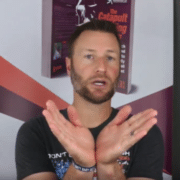Discover how to use the legs when hitting a baseball or softball in the 2023 year. Does a powerful swing depend on footwork, hitting against a firm front side or a straightened front leg, front foot, or do the hips play a big role. Learn batting drills to optimizing legs ARE NOT what you may think…
Answered: “How To Get My Kid To Stop Rising And For Him To Utilize His Legs More During Batting?”
Here’s what we cover in the above video:
- Legs DO NOT equal power – water polo example,

- What is leg function in swing & Adjusting to pitch height,
- Distance between the feet equal more control over line drives,
- GRF’s but not as much as you think,
- Buying time – back foot sideways, directional force, & pushing the “pause” button, and
- How to utilize the legs in the swing?
Hey, what’s going on. It’s Joey Myers again from ‘Hitting Performance Lab’. In this video, we’re going to answer the following reader question:
“How to get my kid stop rising, and for him to utilize his legs more during batting?”
Now this is a question that comes either through a form, survey, or email or even from my local lessons. The coaches out there in the high schools tend to meddle a bit too much, subscribing to the hitting myth that: ‘it’s all about the legs’, or ‘you need to use your legs more’.
In this video, I want to talk about what that means, and what is the function of the legs…
SCIENCE-BASED TRAINING:
Improve your hitting strategy dramatically by applying human movement principles.
Learn not only how and what to train but also the science behind the methods.
Legs DO NOT equal power – water polo example
Legs are only 20-30% of the consistent power equation, and most of that is in the function of the pelvis. If you’re a coach and power is the deficiency in your hitter’s swing, then it’s the spinal engine you want to focus on. The Catapult Loading System is where 70-80% of consistent power is found. The best example I like to share can be found in water polo.
And my favorite demonstration to do for hitters is showing what a beach towel and the spinal engine have in common.
What is Leg Function in Swing & Adjusting to Pitch Height
Now a couple things, one is they help to adjust to pitch height. If you’re looking at hitters like Cody Bellinger of the Dodgers, Joc Pederson of the Dodgers, Corey Seager, looking at Anthony Rizzo of the Cubs or some of the past players like Adrian Beltre or Pedroia. When the pitch is down in the zone, you tend to see them bend their front knee to go down and get it. They tend to do that consistently on those pitches, those lower in the zone pitches, not locking out their front knee like many teach.
I’ve seen these same hitters Rizzo, Bellinger, I’ve seen them with a bent front knee hit balls 440 to 460 feet. So, locking out the front knee IS NOT all about power. So, this raises a question of, if you want a hitter to use their legs more often because you think it has to do with power, well that is just not true – that’s not what we’re seeing. So, adjusting to pitch height, and you can study the hitters discussed as examples.
Distance between the Feet Equal more Control over Line Drives
Distance between the feet, this is a big one, that we can use the legs or utilize the legs to allow hitters to hit more line drives. The problem happens when, say if we are teaching our hitters to skip their back foot that they end up skipping their feet too close together. Or it could be they don’t stride that much. They don’t skip at all and, so their feet tend to be closer together. What we want is what you see with the top 50, top 100 hitters in the big leagues….
You’re going to see distance between their feet. So, whether that is a longer stride and their front foot moves away from their back foot. Whether they don’t skip but they don’t stride as much, you still see that wideness of their feet. You see them scissor, you see different things like that, but what they all have in common, all the top hitters in the big leagues, is they have distance between their feet. When the feet come close together, it makes the hitter taller, which this reader is asking how to keep the hitter from “rising”. The taller the hitter gets, the more in the ground the ball is gonna get hit.
If the hitter knows better, and they try and get the ball in the air, even though they have narrow feet during their turn. Then they’re gonna do something unnatural with their hands to try and get under it, which we don’t want them to do either. Because that is going to cause uppercuts. It’s going to cause inconsistencies in their swing path.
GRF’s, but not as much as you think
I just mentioned that hitters don’t have to lock their front knee out for power. When you think about ground reaction forces (GRF’s), they DO play a role. I’m not taking away from ground reaction forces, or saying “Oh, well the legs don’t do anything in the swing”.
No, they do. It’s about a 20 to 30% increase in power by using the legs. Most of that though is in the pelvis, and the rest in the spinal engine. I tell my hitters that the spinal engine, their combination of your shoulders and how you use them. Neck, shoulders, and pelvis account for about 70 to 80% of the power. That gets you to the wall. The legs help get you over the wall. So, you do need the legs, and it’s like what Dr. Serge Gracovetsky, the author of the ‘Spinal Engine’ said, that locomotion, the arms and legs aren’t necessary for locomotion, they’re an enhancement, they help enhance movement of the spinal engine.
So, we’re not taking away from the legs, the use of the legs, and how they can benefit the swing. It’s just that they’re an enhancement to the spinal engine, the taller the player is, the longer the levers, the more the force multiplier at the end of that lever. So, guys like Aaron Judge and Giancarlo Stanton are gonna have longer levers, if they lengthen those levers at impact. When we’re talking about the front arm shape, they’re gonna hit the ball pound-for-pound, apples-to-apples swings farther than Jose Altuve with the locked out-front arm. It’s just because the longer limbs enhance more, they’re more of a force multiplier.
Buying Time – Back Foot Sideways, Directional Force, & Pushing the “Pause” Button
Buying time. So, the lower half, the legs can help buy time. Jamie Cevallos in his book ‘Positional Hitting’ way back, I think it was in the early 2000’s or mid to late 2000’s. He talked about this idea of a ‘Cushion’. You’ll see a hitter especially, if they’re looking fastball, and they see a curve ball or changeup. You’ll see them actually bend, sink, or cushion into their knees. They use their knees by bending them to buy them a little bit of time to get on time a lot better. It’s pushing the ‘pause’ button.
The other thing we want to do to buy time, is keep the back foot sideways.
We talked about this idea of directional force, Matt Nokes, he says that to hit a ball 400 feet, it takes 8,000 pounds per square inch of force in one direction. In hitting, both in baseball and softball, we have 90 degrees to work with. The other 270 degrees is in foul territory, it doesn’t do a hitter any good or a team any good to play in that 270 degrees outside of a fair territory. We have to stay between the 90s, we have to stay between the lines. If you think about a bowler, every single professional bowler out there, “scissors” their legs.
I’m not saying that all hitters have to scissor. I just give my hitters that option. But if you think about bowlers, they bowl between a two-foot Lane. I don’t know if that’s correct or not, but it’s somewhere around that. They also put a spin on the ball, so if they over rotated their lower half, not keeping their back foot sideways, they’re over rotating their pelvis. Then what you would see is that ball bouncing into the outside lanes. Try scissoring your legs, then try and open your hips up more, and it’s almost impossible.
You want to make sure that we’re creating directional force, and that’s another thing the legs do. They help us stay between that 90 degrees, and use all 90 degrees effectively. That comes in handy at the higher levels when hitting to the opposite field is a lot more important, and when we see shifts. Most of the time, hitters are not very good about going the other way. You can see the hitters that do go the other way very well, their batting averages seem to be higher.
How do we Utilize the legs in the Swing?
Now again, if it’s power you want, this isn’t the place. You want to look at the Catapult Loading System, and harness the power of the spinal engine. If you want a majority of power, 70-80% of consistent power.
Getting Shorter, Staying Shorter
To properly utilize the legs in the swing, you want to look at getting shorter and staying shorter. You see most great hitters when you draw a line over their head before they stride, by the time they get to stride landing, you’re gonna see distance between where they started, and where their head is at stride landing. You’re gonna see what we call ‘Getting Shorter’.
Then as they swing, it’s almost like that bottom ladder rung they create at landing, they tend to stay under that line. What we do is, we could take a PVC pipe. We can put it at the start of the hitter swing, before they even stride…we can put it maybe at their nose or their chin, and we can have them practice getting the top of their head under that PVC pipe. As they swing, stay under that PVC pipe. I’ve also had my hitters get next to a piece of furniture that’s about the same height, then have them stride, and get their head to where, now they’re under the top of that, say dresser or whatever, or picture frame, could be anything around the house.
When they swing, do some slow motion swings, and they stay under that line. That’s a way to get shorter, stay shorter.
Okay to “bend the knee”
It’s okay to bend the knee, I also get my hitters to do this if necessary. We don’t really practice this, but I tell them it’s okay to bend the knee, if the pitch is down in the zone.
Distance between the feet
Also working distance between the feet, you can either get them to stride longer, or you can cut down on their skip. We usually try to manipulate one of those two things or both things to get that distance between the feet, so that allows them to hit more line drives or at least control their line drives.
Keep back foot sideways
Then keeping their back foot sideways. You can use the VeloPro, they use it in pitching a lot. But in hitting, we use the VeloPro.
We tell the hitter to make sure they keep their back foot, their back heel on the ground as they swing. Almost like you would see with George Springer, or Altuve, or Mike Trout, any of those kinds of hitters or in softball Sierra Romero. They keep their back heel on the ground and it turns sideways, so they stay sideways. They do a better job of staying between those 90 degrees.
One last thing on keeping the back foot sideways, as mentioned, scissoring helps with that as well. So, that’s something that you can play around with, and let your hitters’ experiment with.
Hope this answered the question of “How to get my kid to stop rising, and for him to utilize his legs more during the swing”. Make sure that we’re swinging smarter by moving better, and before I let you go…









